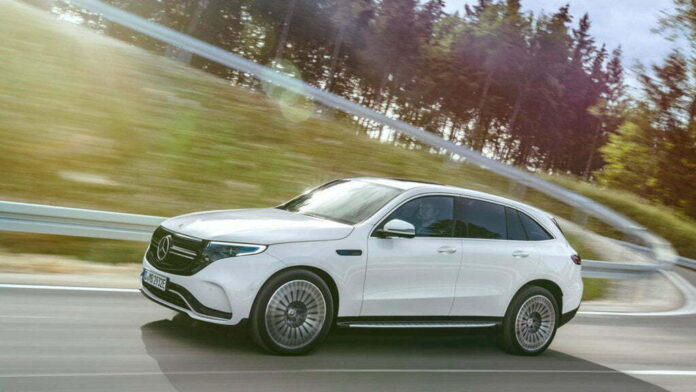Mercedes EQC Electric SUV is based on the GLC which makes practical and has some serious performance on offer
It was at the 2016 Paris Motor Show that Mercedes-Benz first presented its new product and technology brand for electromobility. In mid-2019 the time has come: the EQC is the first Mercedes-Benz vehicle to be launched under the EQ brand. With its seamless, clear design and colour highlights typical of the brand, it is a pioneer for an avant-garde electric look while representing the design idiom of Progressive Luxury. With respect to quality, safety and comfort the EQC is the Mercedes-Benz among electric vehicles. These are accompanied by dynamic performance, thanks to two electric motors at the front and rear axles with a combined output of 300 kW.
As the first Mercedes-Benz model to be launched under the new product and technology brand EQ, the EQC features an all-new drive system development with compact electric drivetrains at each axle. These give the EQC the driving characteristics of an all-wheel drive. To reduce power consumption and increase dynamism, the electric drivetrains are configured differently: the front electric motor is optimised for best possible efficiency in the low to medium load range, while the rear one determines dynamism. Together, they generate an output of 300 kW and a maximum torque of 765 Nm. The lithium-ion battery, which has an energy content of 80 kWh supplies the vehicle with power.
The power consumption and range of electric vehicles depend very much on the driving style. The EQC supports its driver with five driving programmes, each with different characteristics. In the more economical driving modes, the haptic accelerator pedal that prompts the driver to conserve power plays an important role. The driver is also able to influence the recuperation level using so-called paddles behind the steering wheel.
The ECO Assist system gives the driver comprehensive support when driving predictively: by prompting the driver when it is appropriate to come off the accelerator, e.g. because the vehicle is approaching a speed limit, and by functions such as coasting and specific control of recuperation. For this purpose, navigation data, traffic sign recognition and information from the intelligent safety assistants (radar and stereo camera) are linked and processed.
As standard the EQC is equipped with a water-cooled onboard charger (OBC) with a capacity of 7.4 kW, making it suitable for AC charging at home or at public charging stations. Charging at a Mercedes-Benz Wallbox is up to three times faster than at a domestic power socket. It is faster still with DC charging – which is standard for the EQC – for example via CCS (Combined Charging Systems) in Europe and the USA, CHAdeMO in Japan or GB/T in China. Depending on the SoC (status of charge), the EQC can be charged with a maximum output of up to 110 kW at an appropriate charging station. In around 40 minutes, the battery can be charged from 10 to 80 percent SoC (provisional data).
The EQC features the innovative multimedia system MBUX – Mercedes-Benz User Experience – which has numerous EQ-specific functions such as the display of range, charge status and energy flow. EQ optimised navigation, driving modes, charging current and departure time can also be controlled and set via MBUX. The MBUX display has a special EQ tile where numerous EQ features are grouped. Alternatively the user can access the EQ menu of the MBUX system directly using a key in the lower left control panel. Thanks to natural language recognition, the EQ-specific voice control helps the driver to operate the EQC.
By market launch, 200 prototypes and pre-production vehicles of the EQC will have finished tests covering several million kilometres across four continents (Europe, North America, Asia and Africa). The test programme comprises more than 500 individual tests. Like all Mercedes-Benz vehicles, the EQC must complete the demanding standard test programme. There are also special tests for the electric powertrain, the fuel cell, and the interplay of all powertrain components. In the process the test experts are able to build upon the extensive findings from their digital testing work.
In addition to the usual, extensive programme of crash tests, Mercedes-Benz applies further, particularly stringent safety standards to the battery and all component parts carrying electrical current. These standards exceed legal requirements. The vehicle structure of the EQC has been adapted to suit the special requirements of the electrical components and battery, and is configured to achieve the usual high safety level. For example, a new subframe surrounds the drive components located in the front section, and this unit is supported by the usual mounting points.




